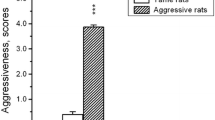Abstract
A behavioral genetic system has been investigated in which the Y chromosome of DBA/1/Bg mice makes an incremental contribution to the adult aggression of B10D1F t , hybrid mice. Crosses with C57BL/10/Bg, C57BL/6/Bg, and DBA/2/Bg have identified a minimum of one incremental and one decremental (suppressor) genetic factor (in addition to the Y chromosome) which are autosomal and which affect the expression of adult intermale aggression in these strains.
Similar content being viewed by others
References
Anderson, P. K., and Hill, J. L. (1965).Mus musculus: Experimental induction of territory formation.Science 148:1753–1755.
Calhoun, J. B. (1956). A comparative study of the social behavior of two inbred strains of house mice.Ecol. Monogr. 26:81–103.
Carthy, J. D., and Ebling, F. J. (1964).The Natural History of Aggression, Academic Press, London.
Christian, J. J. (1970). Social subordination, population density, and mammalian evolution.Science 168:84–90.
Clark, L. H., and Schein, M. W. (1966). Activities associated with conflict behavior in mice.Anim. Behav. 14:44–49.
Court-Brown, W. M. (1968). Males with an XYY sex chromosome complement.J. Med. Genet. 5:341–359.
Crowcroft, P., and Rowe, F. P. (1963). Social organization and territorial behaviour in the wild house-mouse (Mus musculus L.).Proc. Zool. Soc. Lond. 140:517–531.
Defries, J. C., and McClearn, G. E. (1970). Social dominance and Darwinian fitness in the laboratory mouse.Am. Naturalist 104:408–411.
Dennis St. John, R. (1973). Genetic analysis of tail rattling in the mouse.Nature 241:549–551.
Ginsburg, B. E. (1967). Genetic parameters in behavior research. In Hirsch, J. (ed.),Behavior Genetic Analysis, McGraw-Hill, New York, pp. 135–153.
Ginsburg, B. E. (1969). Intra-uterine effects on behavioral capacities in mice. Paper presented at the symposium on the Effects of Intrauterine Experience, XIX International Congress of Psychology, London.
Ginsburg, B. E., and Allee, W. C. (1942). Some effects of conditioning on social dominance and subrdination in inbred strains of mice.Physiol. Zool. 15:485–506.
Guhl, A., Craig, J., and Mueller, C. (1960). Selective breeding for aggressiveness in chickens.Poultry Sci. 39:970–980.
Hamilton, J. B., Walter, R. O., Daniel, R. M.,and Mestler, G. E. (1969). Competition for mating between ordinary and supermale Japanese medaka fish.Anim. Behav 17:168–176.
Hook, E. B. (1973). Behavioral implications of the human XYY genotype.Science 179:139–150.
Jarvik, L. F., Klodin, V., and Matsuyama, S. S. (1973). Human aggression and the extra Y chromosome.Am. Psychologist 28:674–682.
Johnson, R. N. (1972).Aggression in Man and Animals, Saunders, Philadelphia.
Jumonville, J. E. (1968). Influence of genotype treatment interaction in studies of “emotionality” in mice. Ph. D. dissertation, University of Chicago.
Karli, P. (1956). The Norway rat's killing response to the white mouse: An experimental analysis.Behaviour 10:81–103.
Kessler, S., and Moos, R. H. (1970). The XYY karyotype and criminality: A review.J. Psychiat. Res. 7:153–170.
Lagerspetz, L. (1971). Genetic and social causes of aggressive behavior in mice.Scand. J. Psychol. 2:167–173.
Mackintosh, J. H. (1970). Territory formation by laboratory mice.Anim. Behav. 18:177–183.
Owen, D. R. (1972). The 47,XYY male: A review.Psychol. Bull 78:209–233.
Petras, M. L. (1967). Studies of natural populations ofMus musculus. I. Biochemical polymorphisms and their bearing on breeding structure.Evolution 21:250.
Reimer, J. D., and Petras, M. L. (1967). Breeding structure of the house mouse,Mus musculus, in a population cage.J. Mammal. 48:88–99.
Reimer, J. D., and Petras, M. L. (1968). Some aspects of communal populations ofMus musculus in southwestern Ontario.Can. Field Naturalist 82:32–42.
Scott, J. P. (1942). Genetic differences in the social behavior of inbred strains of mice.J. Hered. 33:11–15.
Scott, J. P. (1958).Aggression, University of Chicago Press, Chicago.
Scott, J. P., and Fredericson, E. (1951). The causes of fighting in mice and rats.J. Physiol. Zool. 24:273–309.
Scott, J. P., and Fuller, J. L. (1965).Genetics and Social Behavior of the Dog, University of Chicago Press, Chicago.
Selander, R. K. (1970). Behavior and genetic variation in natural populations.Am. Zoologist 10:53–66.
Southwick, C. H. (1968). Effect of maternal environment on aggressive behavior of inbred mice.Comm. Behav. Biol. 1A:129–132.
Southwick, C. H. (1970).Animal Aggression: Selected Readings, Van Nostrand Reinhold, New York.
Southwick, C. H., and Clark, L. H. (1968). Interstrain differences in aggressive behavior and exploratory activity of inbred mice.Comm. Behav. Biol. 1A:49–59.
Taylor, B. A. (1972). Genetic relationship between inbred strains of mice.J. Hered.63:83–86.
Ulrich, R. (1966): Pain and aggression.Am. Zoologist 6:683–701.
Uyeno, E. (1960). Heredity and environmental aspects of development of behavior in the albino rat.J. Comp. Physiol. Psychol. 53:138–141.
Vale, J. K., Vale, C. A., and Harley, J. P. (1971). Interaction of genotype and population number with regard to aggressive behavior, social grooming, and adrenal and gonadal weight in male mice.Comm. Behav. Biol. 6:209–221.
van Abeelen, J. H. F. (1966). Mouse mutants studied by means of ethological methods. I. Ethogram.Genetica 34:79–94.
van Abeelen J. H. F. (1966). Effects of genotype on mouse behavior.Anim. Behav. 14:218–225.
Walter, R. O., and Hamilton, J. B. (1970). Supermales (YY sex chromosomes) and androgentreated XY males: Competition for mating with female killifishOryzias latipes.Anim. Behav. 18:128–131.
Winer, B. J. (1962).Statistical Principles in Experimental Design, Plenum Press, New York.
yamamoto, T. (1962). Hormonic factors affecting gonadal differentiation in fish.Gen. Comp. Endocrinol. 1:341–345
Yamamoto, T. (1964). The problem of viability of YY zygotes in the medaka.Oryzias latipes. Genetics 50:45–58.
Author information
Authors and Affiliations
Additional information
This study was supported in part by Grants RR 00602-03 from the National Institutes of health, by Grant MH 17088-01 from the National Institute of Mental Health, and by a grant from the Grant Foundation, Inc., awarded to B. E. G. and an NDEA Predoctoral Fellowship awarded to M. K. S.
Rights and permissions
About this article
Cite this article
Selmanoff, M.K., Maxson, S.C. & Ginsburg, B.E. Chromosomal determinants of intermale aggressive behavior in inbred mice. Behav Genet 6, 53–69 (1976). https://doi.org/10.1007/BF01065678
Received:
Accepted:
Issue Date:
DOI: https://doi.org/10.1007/BF01065678



